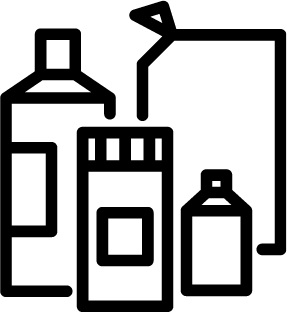FAQs — Porcelain Paving
General Porcelain Paving Questions
1.What is porcelain paving, how is it manufactured, and what distinguishes vitrified porcelain paving?
Porcelain paving is made from a refined clay and mineral mixture, which includes feldspar, quartz, and kaolin. This mixture is pressed and then fired at extremely high temperatures, usually above 1200°C. The high firing temperature ensures the tiles are vitrified, resulting in a dense, hard, and impermeable material with low porosity. This process is why porcelain pavers are so durable and resistant to staining and frost damage and such a good choice for a garden patio. Find out more on the London Stone blog by reading how porcelain paving is made.
2.What are the benefits and positive aspects of choosing porcelain paving slabs?
Choosing porcelain has many advantages, including its contemporary appeal, diversity in colours and textures, low-maintenance nature, affordability, and consistent colour, size, and texture. It doesn't require sealing. Find out more by reading our blog on the top ten reasons why porcelain pavers are an excellent choice for a patio.
3.What is the durability and lifespan of porcelain paving?
Porcelain is baked at high temperatures that cause the ingredients to fuse together into an impervious glass like material. Because of this vitrifying process, porcelain that has been properly installed will last for well over 30 years. That's why London Stone are very confident to offer a 10 year guarantee on all of our Porcelain products.
4.What is the difference between porcelain slabs and porcelain tiles?
The manufacturing process for porcelain paving and porcelain tiles is the same. The difference lies in the thickness: porcelain units under 20mm thickness are classified as tiles. While some may refer to outdoor porcelain products as tiles or garden tiles, the correct term for porcelain designed for outdoor use is paving. We advise that porcelain for outdoor use should be at least 20mm thick.
5.What are the disadvantages of outdoor porcelain tiles? What should you avoid with porcelain tiles?
Whilst porcelain has many advantages over other paving materials, there are some drawbacks. The installation costs of a porcelain patio are generally higher than with other paving materials and there is also the perception that Porcelain lacks the natural appearance and weathering characteristics of other paving materials like stone and clay.
6.Where do I start with a porcelain patio?
There are lots of factors to consider when thinking about whether to choose a porcelain patio, but because the costs for the various paving materials available are relatively comparable, the advice we always give to our customers is that they choose something that they like the look of. To help our clients in making this decision, there are numerous inspiration galleries of finished garden projects on our website.
7.Does porcelain paving vary in colour?
Porcelain is a manufactured material, so its colour is intentionally created to appear a certain way. This ensures colour consistency within the same batches. Variation in colour will exist though between different batches of porcelain, so we strongly advise against mixing batches in a single project. Different sizes are also manufactured in separate batches, so we don't recommend mixing different sizes on the same patio or project.
8.Is each slab of a porcelain product exactly the same?
It would be very dull if each piece of porcelain paving looked the same. Our Italian suppliers design the surface and texture of porcelain so that it looks unique and authentic. Depending on the range and product, there can be as many as 20 unique patterns for each porcelain product before any pattern repetition occurs. When the product aims to mimic the look of natural stone, this assortment of patterns contributes to a more authentic and varied appearance once installed, whilst still maintaining a consistent overall colour and texture.
Questions About Buying and Laying Porcelain Paving
1.Where to buy porcelain pavers?
Landscaping your garden is a big investment, with paving materials often accounting for a large chunk of the budget. This is why we always encourage customers to view a wide range of paving options before finalising their choice. London Stone has 11 showrooms across the country where you can see our materials in real-life settings. Additionally, our consultants are on hand to provide specialised advice to help you make the best decision.
2.Where can I view porcelain paving near me?
If you're interested in viewing quality porcelain paving, London Stone boasts 10 showrooms throughout the United Kingdom. Our showrooms are professionally designed and expertly installed, offering not just inspiration for material selection but also insights into best practice installation methods. Plus, you'll have the chance to discuss your project with our expert sales team. Locate your nearest showroom and visit us today.
3.Is porcelain paving expensive?
Prices were high when porcelain first entered the UK market, but as its popularity has grown, more suppliers have entered the market which has led to more competitive pricing. Recognising that clients have varied budgets, London Stone offers a diverse range of materials at various price points and levels of quality to ensure there's a porcelain option to suit any budget. Browse our collections and get inspired.
4.Is porcelain paving more expensive to lay?
The installation of porcelain paving can be more expensive because of additional installation steps such as priming the back of the pavers, a process not typically needed with other types of paving materials. The hardness of porcelain also makes it more difficult to cut, so specialised bench cutting equipment needs to be bought or hired.
5.What is the estimated cost per square meter for laying a porcelain patio, including the materials and installation?
Clients often ask about the cost to lay a porcelain patio. It's a tough one to answer because landscaper rates vary, as do the rates across different areas of the country. Based on our research, the going rate for porcelain installation ranges from £200 to £300 per square meter, which usually covers labour, materials, and waste disposal. We always advise to get more than one quote for comparison. London Stone provides a directory of landscape contractors, giving you the option to access a list of reputable landscapers in your area.
6.What is the labour cost for laying a porcelain patio?
Based on our experience, most reputable landscaping contractors will not quote a project based on labour charges alone. Reputable firms typically offer a fixed quotation that covers labour, all associated materials, and waste disposal. To find a reputable landscaper in your area visit London Stone Connect.
7.As a patio material, how does porcelain generally compare to natural stone and specifically to sandstone and Indian sandstone?
Porcelain paving is manufactured from refined clays and minerals and fired at high temperatures for unrivalled durability. Porcelain is non-porous, resistant to stains, frost, and water damage, and typically requires very little maintenance. The manufacturing process allows for a consistent colour and texture, and modern porcelain even replicates the look of natural materials, such as wood and stone.
Stone paving is a natural material quarried straight from the ground which gives each piece a distinctive pattern and texture. Sawn sandstone paving for example has a naturally porous surface and usually requires sealing to prevent staining and reduce maintenance. Despite this, when correctly maintained and installed, sandstone paving will still last for decades and will weather and change with time which is one of the benefits of natural stone. In deciding between porcelain and natural stone, you should consider factors like maintenance requirements, budget, and what style of garden you hope to create. Porcelain offers a more uniform appearance and ease of care, while natural stone offers more character and variation in colour and texture.
Questions about How Porcelain Performs Outdoors
1.Does porcelain paving fade?
The colour of porcelain paving will not fade over time. During the manufacturing process, the materials, including colour pigments, are all baked together at extremely high temperatures. This high-heat process leads to vitrification, where all of the raw materials fuse together to create a strong and highly durable material. The vitrification process locks in the colour, maintaining the porcelain's intended colour for years to come.
2.Are porcelain slabs slippery?
There's a misconception that because of its association with glossy interior tiles, porcelain paving is slippery. Outdoor porcelain slabs have been specifically manufactured with surface textures that mimic tried and tested natural stone surface textures, such as sandblasting, flamed and bush hammered, that meet safety standards for outdoor use. Meeting British Standards for external paving, outdoor porcelain slabs come with a minimum slip rating of R11. This makes them comparable to natural stone paving in terms of safety, even in areas that are prone to becoming wet and slippery, guaranteeing a reliable and safe outdoor surface.
3.Can porcelain pavers be used for a driveway?
Yes, porcelain is suitable for high-traffic areas, such as driveways. The most important consideration is the sub-base—it must be accurately installed and should be at least 200mm in depth. Compacting the sub-base in layers of 50mm is also crucial to eliminate any unstable pockets that the vehicle weight could expose, leading to cracking of the paving. It's also important to pay close attention to the mortar bed, ensuring there are no voids that could compromise the paving's integrity. While porcelain is generally more stain resistant than most paving materials, choosing darker colours for your driveway can help in concealing dirt, tire marks, and oil stains.
4.Does porcelain paving scratch?
Porcelain's density makes it highly scratch resistant, so the usual concerns about dragging chairs and garden furniture across your patio that come with stone are lessened. However, if porcelain does get scratched, the mark tends to be more permanent, without the natural weathering process that gradually diminishes scratches in stone. That's why opting for full-bodied porcelain, where the colour runs through the entire body of the tile, is always recommended. With full-bodied porcelain, any scratches that do occur will be less noticeable, as the exposed colour will match the surface colour.
5.How resistant are porcelain pavers to chipping and cracking?
Porcelain is highly durable once installed, and it would take a hard impact from a heavy object to chip it. Porcelain is most vulnerable to damage during transportation and handling. That's why our suppliers take various precautions to minimise the risk of chipping, such as wrapping the slabs in cardboard and protecting the corners. Porcelain is also prone to shock damage, so it's essential to handle it carefully and avoid knocking the slabs against each other.
6.Are porcelain slabs/pavers/paving frost-proof?
The exceptionally low porosity of porcelain, which can be as minimal as 0.01% means that it absorbs virtually zero moisture. This lack of absorption removes the risk of water penetrating the slabs, which in natural stone materials can freeze, expand, and cause cracking and delamination of the paving surface. The most significant risk of frost damage to porcelain paving comes from using porous brush-in resin jointing compounds. These can allow water to get underneath the slabs, potentially causing them to lift during freeze-thaw cycles. To prevent this, it's crucial to choose non-porous jointing materials. Find out more about our recommended pointing materials for porcelain.
7.Do porcelain pavers get hot in the sun?
Like most paving materials, porcelain can absorb heat when exposed to direct sunlight for long periods of time but not anymore than other paving materials. The biggest factor with any material, porcelain, stone, or even composite decking absorbing heat is the colour. Darker colour materials will always absorb heat more quickly, so if this is something that concerns you, we would recommend choosing a light-coloured porcelain.
Practical and Technical Questions
1.How much do porcelain pavers weigh?
We supply various porcelain ranges from different manufacturers, so the weights can vary. The weight of porcelain can be an essential factor for customers working on areas where load is a concern, such as balconies and roof terraces. On average, our porcelain weighs 25kg per m2. For exact weights, we encourage customers to visit the product pages on our website and check the specifications and dimensions section.
2.Do porcelain paving slabs need to be sealed?
Paving becomes stained when moisture carrying dirt is absorbed into the pores of the materials. Unlike some natural stone materials, porcelain paving is extremely dense and absorbs very little moisture, so it generally doesn't need to be sealed. There are certain situations though when your porcelain might need some extra protection. Any example of this might be a garden that experiences a lot of leaf fall, or there might be an area close to a barbecue that is prone to food being dropped. In these instances, porcelain can be sealed to provide that extra protection and it will mean that any stains are superficial and easier to clean. Use Dry Treat Premium Porcelain & Quartz sealer to seal porcelain and if you need further information, speak to a member of our team.
3.How to edge porcelain patio?
Adding an edge to any type of paving is a good way to provide contrast and definition. There are a huge of options available for edging porcelain to enhance its appearance. Setts and planks can create a visually striking contrast and stylishly frame your porcelain paving. There's a lot more to discover on this topic, which is why we wrote a detailed blog on how to edge porcelain.
4.Can you put pots on porcelain patio?
Porcelain is a hard, durable material that doesn't scratch easily, so from this point of view, there is no reason why you can't put pots on porcelain. The problem comes from water stains. Pots that have sat on top of paved areas for a long time can leave unsightly water marks on top of the paving which can be very difficult to remove. You can use pot feet and saucers, but these will also leave marks, so our advice would be not to keep anything on porcelain and if you have garden furniture, this should be moved and the paving underneath it cleaned as regularly as possible.
5.Can Porcelain be edge profiled?
London Stone are one of the only suppliers in the UK who offer an in-house bespoke service and we have pioneered many techniques to add edge profiles to porcelain. Theoretically, all porcelain can be edge profiled but the finish is dependent on the quality of the base material. Some of the cheaper oriental porcelains are not full-bodied and the finished texture and colour is only printed on the upper surface only. Trying to add an edge profile to a material that is not full-bodied results in a contrasting appearance between the surface texture and the freshly profiled edge. The superior European full-bodied porcelain tiles carry the surface colour through the entire thickness of the tile, so they can be bullnosed, pencil rounded or chamfered to a high standard of finish. See our porcelain steps and copings for our full range of edge profiles.
Questions About our Porcelain Ranges
1.Why are there so many different collections?
The essence of our approach is offering choice. With a vast array of porcelain products available, putting them all together in one large category would be overwhelming for customers. By segmenting them into relevant groups, we streamline the selection process. Customers seeking the finest quality can directly access our Luxury range. Those in search of competitively priced options might opt for our Project range or the Budget Italian range. And for those who prefer a big paver, the 800x800 and Large Format collections are readily identifiable. This organisation into sensible categories allows customers to quickly navigate our products and find what they're looking for.
2.What's the difference between Italian and Indian Porcelain?
The main difference between our Italian and Indian porcelain collections is in the internal structure of the material: our Italian porcelain is full-bodied, meaning the surface colour is consistent throughout the entire paver. In contrast, the surface colour of our Indian porcelain is only present on the top surface of the slab. The advantage of full-bodied material is that when edges are profiled, the colour of the freshly profiled edge remains uniform, matching the paver's top surface. Additionally, any scratches or chips, which fortunately are rare because of porcelain's durability, are less noticeable as they don't reveal a different colour. The Italian suppliers have also been manufacturing porcelain for a lot longer than the Indian suppliers, so the surface textures are more lifelike and of a better quality.
3.What's the most popular range?
Our collections are always evolving as we introduce new products, so the popularity of the ranges is quite fluid. However, if we had to choose, our top pick would be the Premium range, because of its extensive variety and choice of stone-textured porcelains like Jura and Florence. Explore our ranges here.
4.Are all the ranges available with steps and copings?
Yes, as experts in hard landscaping London Stone were the first supplier in the UK to truly understand the importance that steps and coping play in many garden schemes in the UK. Subsequently, we made it our mission to stock off the shelf steps and coping stones in most of our stone paving materials. We have followed the same route with porcelain by making steps and copings available across all the porcelain ranges.
5.Is maintenance the same across the different ranges?
Porcelain is low maintenance, and a jet wash and water is usually enough to remove most marks and get the porcelain looking pristine. We would recommend taking a bit more care with the lighter porcelains like Florence White and Slab Khaki and don't leave organic matter, like dead leaves, sitting on the paving for too long. Also consider that marks can show up more on dark colours. The darker grey colours are generally more forgiving as any marks don't show up as much.
6.Why does the Budget Italian and Premium Italian porcelain cost less than the Luxury range?
Our Luxury, Premium and Budget Italian ranges are all produced by the same supplier, in the same factory using the same manufacturing techniques, so this is a good question to ask. The premium and budget-conscious collections were made possible because they are only available in a limited range of colours, have less sophisticated surface textures and because they are manufactured exclusively for London Stone, have no company-wide marketing costs associated with them.
7.What's the most popular product across all the ranges?
There are a several products that really fly, but if we had to pick one that stands out, we'd choose Florence Grey. Florence Grey is inspired by Portuguese Limestone and because we developed the product alongside our Italian supply partners, we currently enjoy worldwide exclusivity on all the products in the Florence range.
8.Can you do bespoke in the different ranges?
Our in-house bespoke production facility is manned by a team of highly skilled and experienced fabricators and masons. Whether you need custom-sized steps, paving, coping, curved cuts, or core drilling in porcelain, our knowledgeable team can handle it all. They are well-versed in porcelain's properties and performance. We've also pioneered our own techniques to create chunky 40mm downstands and 36mm thick bullnoses, both of which are firsts in the UK landscape industry. Contact us with your bespoke porcelain requirements and we'll do the rest.
Questions about Porcelain Installation
1.What are the steps for properly laying porcelain paving slabs for outdoor patios or gardens?
Porcelain slabs are laid in the same way as natural stone paving, with a few differences. When laying porcelain, it is essential to paint the underside of the slabs with slurry primer to ensure complete adhesion of slabs to the mortar, a step not always necessary with natural stone. Porcelain is also more difficult to cut, and you will need to purchase specialist diamond tipped porcelain blades for your cutting equipment. Because porcelain is fully rectified, meaning that unlike natural stone, there is no dimensional tolerance, we recommend that tile spacers are used to achieve a consistent jointing gap. We have written extensive literature on this subject, for further information, read our quick guide to laying porcelain slabs.
2.How long before I can walk on porcelain slabs?
The mortar bed needs time to cure, so after porcelain has been installed, we recommend that you should wait at least 24 hours before walking on it.
3.What is the estimated cost per square meter for laying a porcelain patio, including the materials and installation?
Clients often ask about the cost to lay a porcelain patio. It's a tough one to answer because landscaper rates vary, as do the rates across different areas of the country. Based on our research, the going rate for porcelain installation ranges from £200 to £300 per square meter, which usually covers labour, materials, and waste disposal. We always advise to get more than one quote for comparison. London Stone provides a directory of landscape contractors, giving you the option to access a list of reputable landscapers in your area.
4.What is the labour cost for laying a porcelain patio?
Based on our experience, most reputable landscaping contractors will not quote a project based on labour charges alone. Reputable firms typically offer a fixed quotation that covers labour, all associated materials, and waste disposal. To find a reputable landscaper in your area visit London Stone Connect.
Specialist Porcelain Installation Questions
1.Can you lay porcelain slabs without slurry?
Laying porcelain slabs without a slurry primer is a huge no. Porcelain is a dense material with low porosity, which means without a slurry primer, the bedding mortar will not adhere to the underside of the slab. To mitigate against the lack of porosity in porcelain, the slurry primer acts as a bond bridge between the underside of the paver and the mortar bed. It is possible to make your own slurry primer on site by mixing cement, water and SBR but we would strongly recommend that you purchase a specialist pre-mixed product like Larsen Streetscape PS Primer.
2.Why are my porcelain slabs lifting?
There are several reasons why porcelain paving slabs might lift. The most common issue is that the slabs have not adhered properly to the bedding layer. This could be due to the slabs not being adequately primed or the bedding layer lacking sufficient moisture, or the slabs not being settled firmly enough into the bedding layer. These problems often become apparent during winter when sharp frosts cause water to seep between the bedding layer and the paving; this water then freezes and expands, leading to the lifting of the slabs. Additionally, ground heave is another potential cause, which can occur on clay substrates after extended periods of hot weather.
3.Can porcelain paving be installed on pedestals?
Yes. Porcelain is a very strong material. A 600x600x20mm tile will happily sit on a pedestal system without a central support pedestal, unlike most natural stone of the same thickness. For some of the larger sizes like 1200x600 & 800x800 we would always recommend using a central support pedestal. Porcelain is used with a pedestal system extensively on roof terraces and other areas that are subject to weight restrictions.
4.Can porcelain pavers be laid on sand?
Porcelain paving cannot be laid on sand as there is no adhesive property to bind the slabs to the sand, leading to potential movement and instability over time. For the proper installation techniques, please refer to our comprehensive installation guide.
5.Should porcelain pavers be installed over concrete?
Yes, porcelain paving can be laid on top of a concrete base. Interior porcelain tiles are usually laid on a concrete base and porcelain paving, apart from the thickness, are identical to interior porcelain tiles. Builders who are experienced in laying interior tiles on concrete bases will often use the same method if they are laying an outdoor patio. Landscapers, in our experience will use the traditional paving method of an MOT sub-base, mortar bed and primed slabs.
6.How should porcelain slabs be laid on a concrete base?
When laying porcelain paving on a concrete slab, it's important to have a flat surface with the correct falls to facilitate water runoff. Any imperfections or dips in the slab should be filled with a self-levelling compound. Spread exterior tile adhesive evenly using a notched trowel before placing the porcelain paver on top. You may need to tap the paver down gently but if the concrete base is flat, the paver should find the correct level on its own. For a more comprehensive guide, please refer to our detailed installation document, that provides complete information on installing porcelain paving on a concrete slab.
7.Can you lay porcelain slabs on an existing patio?
In theory, it is possible to lay porcelain paving over an existing patio, but we do not recommend this approach. If laying on top of an existing subbase, the condition of the subbase is unknown, and any problems with the subbase could cause the new patio to fail. It is far better to do the job correctly by removing the existing paving, installing a new subbase, and then laying the porcelain slabs. This process ensures that your porcelain patio will stand the test of time.
8.What is the recommended thickness of mortar beds for porcelain paving?
For installing a porcelain patio, we advise using a mortar bed with a thickness ranging from 30 to 50mm. The recommended mortar mix ratio is 4 parts sharp sand to 1 part cement, and the mixture should have a semi-dry consistency.
9.What is the recommended gradient or fall for laying porcelain slabs to ensure proper drainage?
The British standards will soon be updating their guidance to state that the fall on porcelain paving should be 1:60, but we feel this is excessive and recommend that our products are installed with a 1:80 fall. For further information on how to incorporate falls into patios, read our detailed installation guide.
Questions about Grouting Porcelain
1.Is it possible to lay porcelain slabs without a gap, and is it necessary to grout outdoor porcelain tiles, or can they be installed with butt joints?
Porcelain paving, as with any type of paving, should not be laid butt jointed; there must always be a gap which should then be filled with a suitable jointing material. If the joints are not grouted, water can seep into the bedding layer and through freeze-thaw cycles, this water can expand and potentially cause the paving to lift.
2.What is the recommended joint size for porcelain paving slabs?
Based on our experience, the optimal joint width for porcelain paving is 5mm. A joint narrower than 5mm can result in weakened grout strength and integrity. Conversely, a joint wider than 5mm can draw attention to the jointing gaps rather than highlighting the beauty of the paving material itself.
3.What is the proper method for grouting a porcelain paving patio?
To find out more, read our comprehensive guide on grouting porcelain.
4.Which type of grout is considered the best for porcelain paving slabs?
There's a huge selection of jointing compounds available on the market, but not all of them are appropriate for use with outdoor porcelain. The chosen compound must be non-porous, which excludes options like GFTK, EasyJoint, and the other resin-based sweep-in compounds. While some contractors opt for cement based Flowpoint, which is acceptable, we recommend using exterior tile grout. Exterior tile grout has been designed specifically for use with porcelain which ensures optimal performance. Check out our full range of grouts.
Questions about Cutting Porcelain Slabs
1.What is the proper technique for cutting porcelain paving slabs to avoid chipping, and is it difficult to cut porcelain slabs?
The hardness of porcelain can pose a challenge when trying to achieve accurate and clean cuts: having the right cutting equipment is essential. One major challenge involves cutting the porcelain so that the edges don't become chipped and spalled. The best way to avoid this is by using a wet bench saw fitted with a continuous rim porcelain blade. The bench saw stabilises the paving to prevent movement during cutting, while the water cools the blade during cutting, facilitating a smooth cut. The continuous rim blade is specifically designed to ensure that the porcelain does not chip or spall, resulting in a clean and precise cut.
It's also good practice to sharpen the blade after every few cuts. This can be done by running the blade through a concrete block that exposes the new diamond grit on the blade. Tension also exists in porcelain because of the way it's manufactured. This can cause the slabs to crack during cutting. This can be overcome but cutting the two edges first and releasing the tension. Also make sure to wear eye and ear protection.
Questions about Maintaining a Porcelain Patio
1.Does porcelain paving require no maintenance, and are porcelain slabs or pavers resistant to staining?
There is no such thing as a maintenance-free patio and like any other surface material, porcelain can also stain. However, porcelain is lower maintenance than the majority of other paving options. With virtually zero-porosity, porcelain doesn't absorb stains easily and often a jet wash is all that's needed to return your patio to its original pristine condition. Any stains that do occur are likely to be superficial and they should clean up easily. One thing to be aware of with porcelain, especially with some of the lighter colours like Slab Khaki, is fallen leaves. Fallen leaves that are left on the paving for any length of time begin to break down and this can stain the paving and be difficult to move. Because of this, we advise that any fallen leaves on your patio are swept up as soon as is practically possible.
2.What are the best porcelain patio cleaners?
Because porcelain is a non-porous material, it generally doesn't require the use of patio cleaners for maintenance. Most stains are superficial and can be easily removed without specialized products. There are certain stains though that may require a specialist cleaner. Lithofin Outdoor Cleaner is designed to remove organic matter, so is the perfect product to remove those stubborn leaf stains. To remove cement or grout stains, we would recommend using Lithofin Builders Clean. When using any cleaning products, always follow the instructions on the packet and if you need any advice, contact a member of our team.
3.What is the best method for cleaning porcelain patio tiles and paving slabs?
Porcelain paving is one of the lowest maintenance paving materials you can buy. Often all that is needed is a jetwash or a broom and clean water. However, occasionally you might need a more targeted approach. We've written a blog that gives you all the information on how to clean a porcelain patio.
4.How to remove cement stains on porcelain paving?
If cement spills on your porcelain patio during installation, it's best to wipe it away before it dries. If it has already dried, gently scrape off large pieces with a wooden or plastic spatula—don't use metal as it may scratch the paving surface. Then, use a jet wash to remove any residual stains. If stains persist, apply Lithofin Builders Clean with a brush, let it sit for a few minutes, and jet wash it off. Avoid metal tools to prevent scratches and always follow product instructions when using chemical cleaners.
5.How to clean porcelain patio tiles after grouting?
After grouting porcelain paving, you might notice a fine white residue on the surface, known as grout haze. This is a common occurrence and not a cause for concern. In most cases, this residue can be removed with a jet wash and will quickly dissipate. If the grout haze is particularly stubborn, a chemical cleaning solution might be necessary. In such instances, we recommend using Lithofin Builders Clean. Always adhere to the instructions on the product packaging when using specialized cleaning products, and for further advice, don't hesitate to contact our team.
6.Do porcelain slabs go green?
Algae typically thrives on porous natural stone because it settles and grows in the pores of the stone. This problem is significantly reduced with porcelain, as it is non-porous. Algae can still grow on porcelain if the paving has been installed with an insufficient fall, leading to water pooling on the surface. This stagnant water then becomes the ideal environment for algae to flourish. In this instance, porcelain, like natural stone, can turn green.
7.Is it safe to use a jet or pressure wash on a porcelain patio?
Yes, porcelain can be jet washed, and with less caution than when jet washing stone, which can deteriorate under the pressure of the water spray. The main risk when jet washing porcelain is potentially loosening the jointing compound. For this reason, when jet washing porcelain, hold the nozzle at a 45-degree angle to the paving, approximately 30cm away, and avoid using the finest nozzle setting to protect the integrity of the joints.














